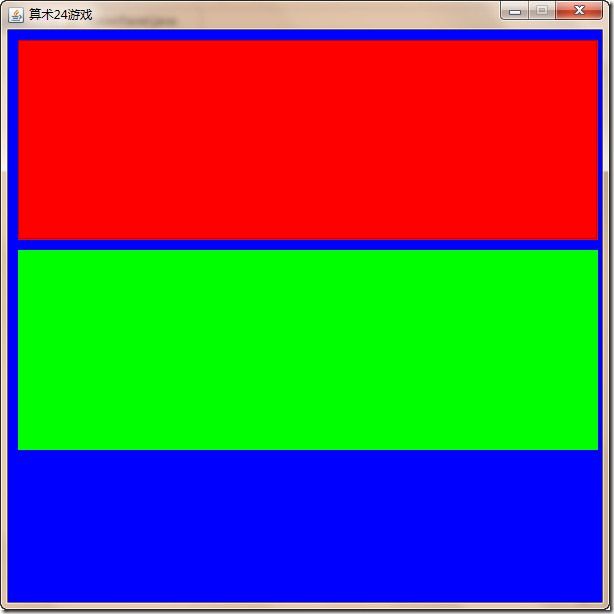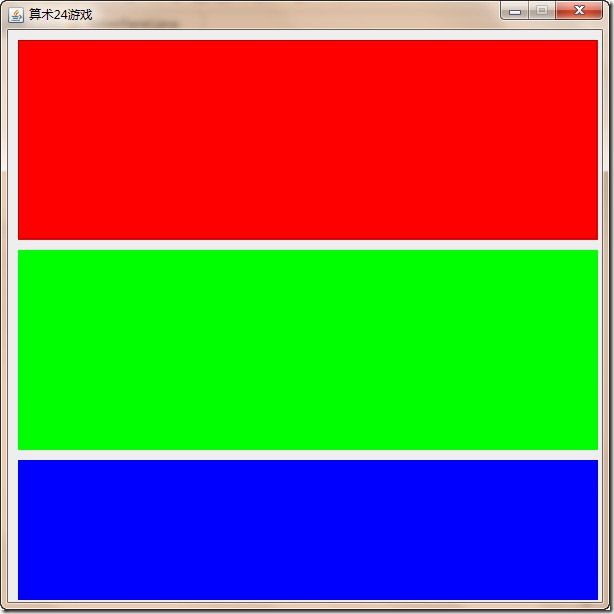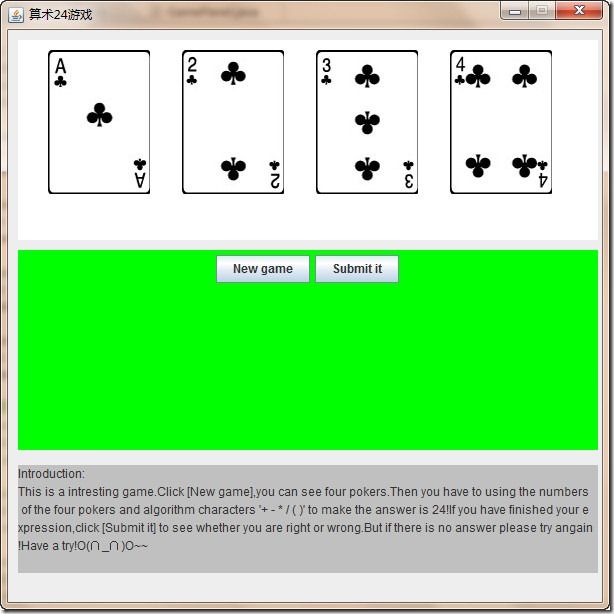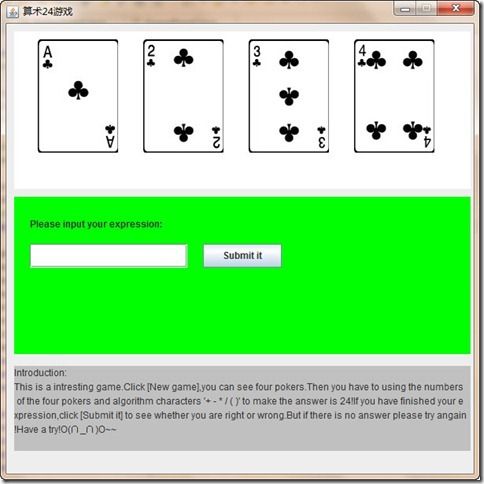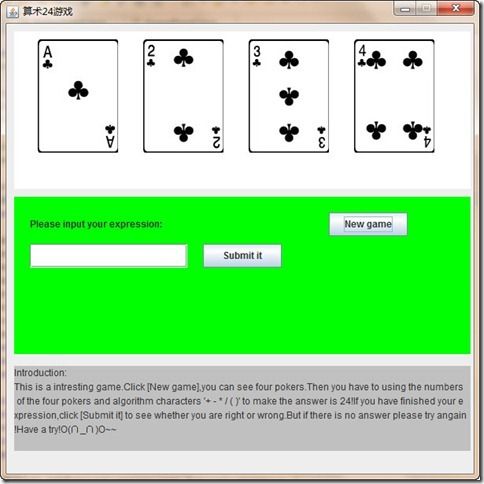JavaSE Swing知识漏洞
1. Frame 的默认布局方式是 BorderLayout,所以如果要使用 setBounds 方法给组件设置具体位置时最好是 将默认的布局方式去掉,设置为null
例如:
// this.setLayout(null); gamePanel.setVisible(true); pokerPanel.setVisible(true); gameInfoPanel.setVisible(true); pokerPanel.setBounds(10, 10, 580, 200); pokerPanel.setBackground(Color.RED); gamePanel.setBounds(10, 220, 580, 200); gamePanel.setBackground(Color.GREEN); gameInfoPanel.setBounds(10, 430, 580, 140); gameInfoPanel.setBackground(Color.BLUE); add(pokerPanel); add(gamePanel); add(gameInfoPanel);
效果:无论是哪个panel最后加上去都会铺满整个frame
去掉注释后的正确效果:
2. 显示图片
第一种方法是给label放一个 图片,
实例:
package com; import java.awt.BorderLayout; import java.net.URL; import javax.swing.*; public class ShowImage extends JFrame{ /** * @param args */ public ShowImage() { JPanel panel=new JPanel(new BorderLayout()); JPanel panel2=new JPanel(new BorderLayout()); JPanel panel3=new JPanel(new BorderLayout()); String urlString="D:\\MyEclipse 6.0\\新建文件夹\\Exam\\bin\\images\\winter.jpg"; JLabel label=new JLabel(new ImageIcon(urlString)); URL url=getClass().getResource("/images/orz2.jpg"); JLabel label2=new JLabel(new ImageIcon(url)); URL url2=getClass().getResource("/images/orz.jpg"); JLabel label3=new JLabel(new ImageIcon(url2)); panel.add(label,BorderLayout.CENTER); panel2.add(label2,BorderLayout.CENTER); panel3.add(label3,BorderLayout.CENTER); this.getContentPane().setLayout(new BorderLayout()); this.getContentPane().add(panel,BorderLayout.CENTER); this.getContentPane().add(panel2,BorderLayout.SOUTH); this.getContentPane().add(panel3,BorderLayout.EAST); this.setSize(400, 300); this.setDefaultCloseOperation(JFrame.EXIT_ON_CLOSE); this.setTitle("显示图像"); this.setVisible(true); } public static void main(String[] args) { // TODO Auto-generated method stub ShowImage showImage=new ShowImage(); } }
label1是使用绝对路径,label2和label3使用的是相对路径,相对于类文件(.class文件)的路径
另一种更好的画图方法:使用 g.drawImage
实例:
Color color=g.getColor();//首先要重画面板,清除前面的所有内容 g.setColor(this.getBackground()); g.fillRect(0, 0, this.getWidth(), this.getHeight()); g.setColor(color); URL url1 = getClass().getResource("images/"+a+".jpg"); Image image1=getToolkit().getImage(url1); g.drawImage(image1, 20, 10, null, this);
我的实例:
URL url1 = getClass().getResource("images/"+a+".jpg"); Image image1=getToolkit().getImage(url1); g.drawImage(image1, 30, 10, null, this); URL url2 = getClass().getResource("images/"+b+".jpg"); Image image2=getToolkit().getImage(url2); g.drawImage(image2, 164, 10, null, this); URL url3 = getClass().getResource("images/"+c+".jpg"); Image image3=getToolkit().getImage(url3); g.drawImage(image3, 298, 10, null, this); URL url4 = getClass().getResource("images/"+d+".jpg"); Image image4=getToolkit().getImage(url4); g.drawImage(image4, 432, 10, null, this); //之前使用的是label,不是很好 // URL url1 = getClass().getResource("images/"+a+".jpg"); // JLabel label1 = new JLabel(new ImageIcon(url1)); // this.add(label1); // // URL url2 = getClass().getResource("images/"+b+".jpg"); // JLabel label2 = new JLabel(new ImageIcon(url2)); // this.add(label2); // // URL url3 = getClass().getResource("images/"+c+".jpg"); // JLabel label3 = new JLabel(new ImageIcon(url3)); // this.add(label3); // // URL url4 = getClass().getResource("images/"+d+".jpg"); // JLabel label4 = new JLabel(new ImageIcon(url4)); // this.add(label4);
效果图:
3.setBounds和setLocation
实例:
JButton newButton = new JButton("New game"); newButton.setLocation(300, 20); // newButton.setBounds(400, 20,100,30); gamePanel.add(newButton);
效果是:【左图:setLocation 】没有显示 【右图:setBounds 】 显示
所以说:如果要让它显示出来,要么使用setBounds或者setLocation加上setSize(两个都要写,不然就不会显示出来了)
